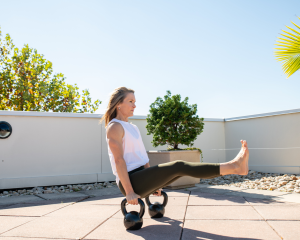Should you weigh yourself daily, weekly, monthly or not at all? Where I am landing on this one just might surprise you. I’ll give you a hint: there is no real perfect number for any of us. The only perfect is you – not a number prescribed by someone else in a government office, a magazine cover or social media. It is a place, a life and a beautiful existence that is all yours – including whatever the scale says when you head to your annual physical.
Did you know there is an app where you can visualize yourself at a certain weight?
We hear friends and clients yearn for weight loss – – – often. After all, I own a fitness business. This is why the “big box” gym model of American gyms and the weight loss industry thrive. Americans want to lose weight. Those businesses realize the pocketbook will match the desire for the long haul, yet the desire will go away while the pocketbook is still doling out the monthly fee.
Most often, 10 pounds is the amount desired. Americans not only want a quick fix, we want it to be something fairly “easy”. And, do you ever wonder why 10 pounds?
Let’s be clear: Weight loss isn’t only about positive relationships with mirrors and clothes. Fat loss can contribute to improved daily functionality, happiness and just generally a healthier life, for sure.
Mark Sisson tells us “Fat loss is not simply a flighty pursuit. It solves some very serious problems.”
To name just three of many, 1) joints feel better / less pain 2) hunger becomes more manageable if your weight-loss journey did not include starvation-type tactics relying substantially on healthy fats, proteins and colorful vegetables 3) sleep quality can be reduced or resolved with weight loss from the abdominal area. These are just three, and really credible reasons for weight loss – if necessary.
In this three part series, I will explore how holding onto unrealistic and society produced body composition goals may actually hamper your fitness and health progress. These unhealthy goals can put undue stress on your body which can disrupt levels of cortisol, the stress hormone, causing real harm to your health. This can lead to various behaviors such as micromanaging your food and supplement intake, becoming guilt-ridden if you miss a single workout, beating yourself up because you ate pizza or cake and being obsessed with measures such as body fat percentage and scale weight. It can become a real domino effect. And the only one losing – not pounds – is you.
We associate weight loss with success, “fitness” with happiness and beauty with power. Yet, weight gain, on the other hand, is rarely ever something to be celebrated. This is even when it is necessary for a healthy life. We all know the Centers for Disease Control and Prevention (CDC) numbers, realize childhood obesity is at an all time high and our own adult size weight is sadly above world standards. Yet, let’s just pause on our own fitness – – – and what it means to being truly you, not who the magazines, your friends or another source of shame may make of you.
Research abounds on the effects of daily, weekly and/or monthly weigh-ins. There is research for the “normal”, the “overweight” and the “obese”. I’ve really attempted to come up with the best method for determining when someone is normal, overweight and obese.
Before we go to the benefits and costs of weighing, let’s first aim for a definition of the “magic” number for which we seem to aim when we step on that cold metal.
First, let’s start with the definition of overweight, obese and normal weight. Of all questions I hear most from clients and friends that make my blood boil, this may top the list: “How much am I really supposed to weigh?” Not because I don’t have an answer, but because why does it matter to you? Below are the commonly used metrics in our country for measuring “normal”, “overweight” and “obese”.
- Body Mass Index (BMI) is a number based on a person’s weight and height that provides a way to estimate the effect of weight on health. The higher the BMI, many believe, the greater the risk of some diseases, including high blood pressure, heart disease and stroke. This is widely used by the medical community.
- Another is Waist-Hip Ratio, like BMI, leaves out the body type and the muscle mass of the individual. A waist to hip ratio really measures an individual’s risk for cardiovascular health problems.
- The Hamwi Approach: Dr. GJ Hamwi’s formulas for calculating an individual’s ideal weight are derived from the belief that a woman exactly 5 feet tall should weigh 100 pounds, and that a man that exactly 5 feet tall should weigh 106 pounds. Hamwi’s approach does not take into effect lean muscle, like many of the others. You can guess how I feel about this by looking at our image.
- Waist to Height Ratio (WtHR): A Fitness on the Run Favorite, Dr. Margaret Ashwell studied the research completed between 1950 and 2009 on the effects of WtHR against all measures like BMI, Waist Circumference (WC) and Body Fat. By far, WtHR was the best indicator of heart disease and cardiovascular problems and longevity.
- The Body Fat School says any male whose body fat percentage is over 25% or female over 31% is either overweight or possibly obese.
- The Weight to Height Chart from the National Institutes of Health (NIH):
Confused yet? Stay tuned for next week’s article if, based on the read out from your scale and what’s really behind that number you see. You’ll begin to explore if you truly have “fat” and “thin” days.



